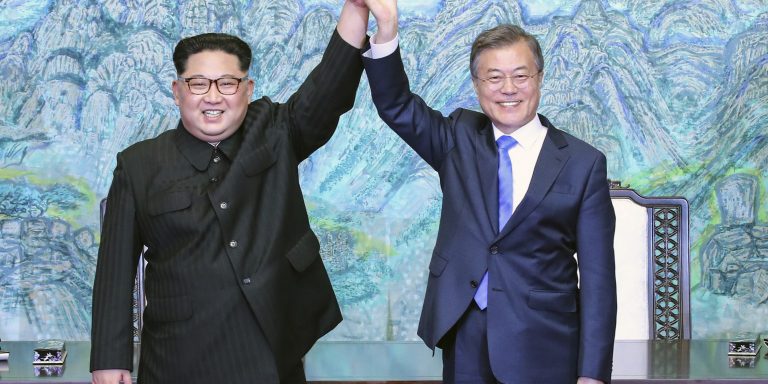INTELBRIEF
May 1, 2018
IntelBrief: Hope and Hype with North Korea

- The brief April 27 meeting between the leaders of North and South Korea is a significant achievement that should be encouraged.
- Talk of ‘total denuclearization’ will have to be followed up with extensive and frustrating negotiations but a chance for peace demands the effort.
- North Korea has used this approach before—1992, 1994, 2005, and 2012—and there should be no illusions as to the depth of the task at hand.
- As it helps promote a nuclear ‘deal’ with North Korea, the U.S. is likely to pull out of a multilateral agreement with Iran.
.
At times, imagery and symbolism matter more than substance. The April 27 mini-summit between the leader of North Korea, Kim Jong Un, and South Korean President Moon Jae-in might be such a moment, in which the rhetoric around promoting peace generates the foundation for actual peace—not just the absence of active hostilities. While nothing is certain, the effort is certainly worth it.
There are compelling reasons to doubt the outcome of this latest effort, however symbolic and hopeful it is. North Korea signed a ‘denuclearization’ treaty with South Korea in 1992 but proceeded to develop nuclear weapons. It signed a 1994 denuclearization agreement with the U.S., a 2005 denuclearization treaty with China, Japan, North Korea, Russia, South Korea, and the U.S., and a nuclear ‘halt’ agreement in 2012 with the U.S. Throughout these negotiations, Pyongyang kept advancing its program to where it stands now.
There are differences this time that may or may not provide the needed catalyst for serious change. Kim Jong Un appears secure in his position after a few years of solidifying his control, but the pressure to change the trajectory of his country’s path with South Korea and the U.S. is enormous. Some have stated that the over-the-top rhetoric by President Trump, essentially threatening war via Twitter, forced Kim Jong Un to the negotiating table. This is impossible to know in the public arena; there are likely deeper dynamics at play between the two Koreas, along with regional concerns that are driving the recent momentum. Still, the trend line has shifted from credible concern of an armed conflict between the U.S. and North Korea just a few months ago to planning for an unprecedented meeting between a sitting U.S. president and the leader of North Korea. The talks may not lead to lasting peace, but the rush to war has been slowed and that is positive.
The U.S. is hoping to sever any connection between it seeking a nuclear weapons deal with North Korea and leaving the years-long negotiated nuclear weapons deal with Iran. The Trump Administration is likely to walk away from the Joint Comprehensive Plan of Action, a move that is strongly opposed by the other signatories: China, France, Germany, Russia, the U.K., the E.U., and Iran. While traveling to Tel Aviv on April 29, new Secretary of State Pompeo said flatly that he did not think the U.S. walking away from one nuclear agreement would have any bearing on whether North Korea would enter into one with the U.S. Pompeo said he did not ‘think Kim Jong Un is staring at the Iran deal and saying, ‘Oh, goodness, if they get out of that deal, I won’t talk to the Americans anymore,’ and added that he thought Kim Jong Un had ‘higher priorities, things that he is more concerned about than whether or not the Americans stay.’ A tremendous amount rests on the validity of that assumption.
.
For tailored research and analysis, please contact: info@thesoufancenter.org
[video width="960" height="540" mp4="https://thesoufancenter.org/wp-content/uploads/2018/05/Final-Edit-1-184.mp4" poster="https://thesoufancenter.org/wp-content/uploads/2018/05/AP_18119337844964.jpg"][/video]